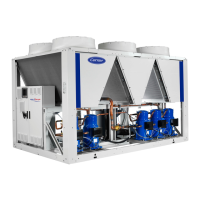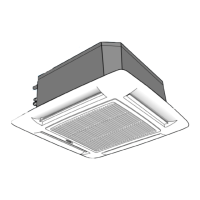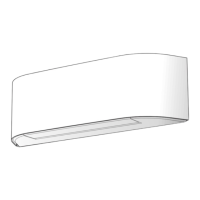50
Before opening a refrigerant circuit, purge the circuit and
consult the pressure gauges.
Change the refrigerant after an equipment failure, following
a procedure such as the one described in NF E29-795 or carry
out a refrigerant analysis in a specialist laboratory.
If the refrigerant circuit remains open for longer than a day
after an intervention (such as a component replacement),
the openings must be plugged and the circuit must be charged
with nitrogen (inertia principle). The objective is to prevent
penetration of atmospheric humidity and the resulting
corrosion on the internal walls and on unpro-tected steel
surfaces.
19.5 - Leak detection
Never use oxygen or dry air, as this would cause a risk of re
or explosion.
• Carry out a leak detection test on the whole system using
the following methods: pressure test using dehydrated
nitrogen or a mixture of nitrogen and refrigerant used
for the system, helium leak test.
• Connect the compressor to the system by opening the
valves.
• The duration of the test must be sufcient to guaran-tee
the absence of very small leaks in the circuit.
• Use specic tools, designed for leak detection.
• The low-pressure side test pressure must not exceed
pressure Ps indicated on the compressor and unit name
plates.
• If there is a leak, repair it and carry out the leak detec-tion
test again.
19.6 - Evacuation
To evacuate the system, observe the following recommen-
dations:
Connect the vacuum pump to the high (HP) and low-pressure
(LP) side for evacuation of the complete circuit. Never use
the compressor as a vaccum pump.
All units are equipped with valves with 3/8” SAE connections
on the suction, discharge and liquid lines, permitting the
connection of large-diameter flexible pipes limiting the
pressure drops for the evacuation.
1. The vacuum level achieved must be 0.67 mbar (500 µm
Hg).
2. Wait 30 minutes.
3. If the pressure increases rapidly, the system ist not leak-
tight. Localise and repair the leaks. Restart the evacuation
procedure and repeat steps 1, 2, etc.
4. If the pressure increeases slowly, this indicates that
moisture is present inside the system. Break the vacuum
with nitrogen and restart the evacuation procedure (steps
1, 2, etc.).
5. Repeat the evacuation procedure (steps 1, 2); a vacuum
level of 0.67 mbar (500 µm Hg) must be achieved and
maintained for four hours.
This vacuum level must be measured at one of the system
connections and not at the vacuum pump pressure gauge.
ATTENTION: Do not use a megohmmeter and do not place
any stress on the compressor motor when the system has
been evacuated. There is a risk of internal short circuits
between the motor windings.
Do not use additives for leak detection. Do not use CFCs/
HCFCs as tracer uids for leak detection.
19.7 - Recharging liquid refrigerant
CAUTION: The units are charged with liquid R-410A
refrigerant.
With high-pressure R-410A refrigerant the unit operating
pressure is above 4000 kPa (40 bar), the pressure at 35 °C air
temperature is 50% higher than for R-22. Special equipment
must be used when working on the refrigerant circuit
(pressure gauge, charge transfer, etc.).
All checks must be pressure tests, and the appropriate
pressure/temperature ratio table must be used to determine
the corresponding saturated temperatures (saturated bubble
point curve or saturated dew point curve).
Leak detection is especially important for units charged
with refrigerant R-410A. Depending on whether the leak
occurs in the liquid or in the vapour phase, the proportion
of the different components in the remaining liquid is not
the same.
NOTE: Regularly carry out leak checks and immediately
repair any leak found.
19.8 - Characteristics of R-410A
Saturated temperatures (°C) based on the relative pressure (in kPa)
Satur.
temp.
Relative
pressure
Satur.
temp.
Relative
pressure
Satur.
temp.
Relative
pressure
Satur.
temp.
Relative
pressure
-20 297 4 807 28 1687 52 3088
-19 312 5 835 29 1734 53 3161
-18 328 6 864 30 1781 54 3234
-17 345 7 894 31 1830 55 3310
-16 361 8 924 32 1880 56 3386
-15 379 9 956 33 1930 57 3464
-14 397 10 987 34 1981 58 3543
-13 415 11 1020 35 2034 59 3624
-12 434 12 1053 36 2087 60 3706
-11 453 13 1087 37 2142 61 3789
-10 473 14 1121 38 2197 62 3874
-9 493 15 1156 39 2253 63 3961
-8 514 16 1192 40 2311 64 4049
-7 535 17 1229 41 2369 65 4138
-6 557 18 1267 42 2429 66 4229
-5 579 19 1305 43 2490 67 4322
-4 602 20 1344 44 2551 68 4416
-3 626 21 1384 45 2614 69 4512
-2 650 22 1425 46 2678 70 4610
-1 674 23 1467 47 2744
0 700 24 1509 48 2810
1 726 26 1596 49 2878
2 752 25 1552 50 2947
3 779 27 1641 51 3017

